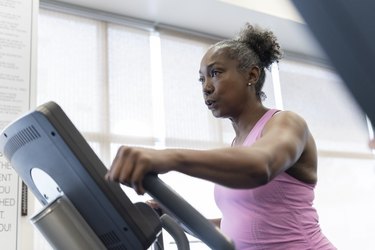
If you're going to spend the time and effort it takes to complete a cardio workout, it's important to weigh the pros and cons of a stationary bike vs. an elliptical, particularly if you're trying to lose weight.
While it mostly comes down to access, personal preference and which one you'll stick with consistently, an elliptical works both arms and legs, while the stationary bike works your legs and core. Both machines are ideal options for low-impact cardio workouts.
Video of the Day
Video of the Day
Stationary Bike vs. Elliptical
Stationary Bike | Elliptical | |
|---|---|---|
Type of Workout | Cardio | Cardio |
Calories Burned | 252 to 360 in 30 minutes | 324 in 30 minutes |
Adjustable | Resistance | Resistance and incline |
Targets | Lower body and Core | Full body |
Low-Impact | Yes | Yes |
Downside | Uncomfortable seat | Requires balance and coordination |
Benefits of Elliptical Machines
Elliptical machines are a popular choice for cardio as they're a cross between a stair stepper and a ski machine. They work your legs in a circular up-and-down motion while also working your arms with the moveable handles. You can adjust the resistance and incline to match your fitness level.
1. Burn Calories: Using the elliptical machine is a great way to burn calories. According to Harvard Health Publishing, a 155-pound person will burn 324 calories in 30 minutes.
2. Full-Body Workout: The movable poles or handles work your arms and shoulders, while your lower body (hamstrings, quadriceps and glutes) gets an intense workout too. You can also cycle your legs backward instead of forward, which will challenge your hamstrings and calves to a greater extent, per the Cleveland Clinic. The elliptical engages your core muscles as well.
3. Low-Impact: This machine puts less stress on your joints than running, per the Mayo Clinic, making it ideal for those who have knee or hip injuries or arthritis. This kind of low-impact workout is great for cross-training for long-distance runners as it may help prevent stress fractures.
The downside is that if you have balance issues, the circular motion of the legs may be difficult to perform.
Related Reading
Benefits of an Exercise Bike
An exercise bike, or stationary bike, is another great machine for getting a cardiovascular workout. It requires little coordination and the resistance can be adjusted to make it more difficult and force your muscles to work harder.
1. Burns Calories: The number of calories you burn can vary depending on how fast you're cycling. In general, a 155-pound person can burn 252 calories when pedaling at a moderate speed for 30 minutes, per Harvard Health Publishing. If you bump it up to a vigorous speed, you'll burn 360 calories in half an hour.
2. Low-Impact Lower-Body Workout: A stationary bike is a great way to strengthen your legs and core without stressing your joints, according to the Cleveland Clinic. Cycling, in general, is beneficial for those with osteoarthritis.
3. Versatile Workout: You can either cycle at home, go to the gym or attend spinning classes if you enjoy group exercise. The bike seat can be uncomfortable, but adding a padded model will often fix this issue.
Related Reading
Bottom Line: Stationary Bike vs. Elliptical for Weight Loss
When used at high-intensity, a stationary bike burns slightly more calories than the elliptical, potentially making it a better choice for those trying to lose weight. The elliptical, however, helps strengthen both your upper and lower body.
Both machines are considered low-impact, making them ideal for those with joint problems as well as for cross-training. The elliptical machine is more weight-bearing than the stationary bike, so it may help improve bone density. But if you have knee, hip or ankle pain, the stationary bike might be a better choice for getting a cardiovascular workout without stressing the joints.
Whichever machine you choose, it's important you work to get your heart rate in the target zone, according to the American Heart Association. To find your maximum heart rate, take 220 and subtract your age. Try to get your heart rate at 50 to 85 percent of your maximum heart rate, depending on your workout intensity.
For example, if you're 40 years old, then your maximum heart rate is 180 beats per minute (bpm). While working out, your heart rate should be between 90 and 153 bpm. If it's lower than that, push yourself a little more. If it's too high, back off the intensity.
If you can't decide between elliptical versus bike, you can use either machines to get a fantastic cardio workout. Plus, it's a great way to keep your routine varied.
- Harvard Medical School: "Calories Burned in 30 Minutes for People of Three Different Weights"
- Cleveland Clinic: "Treadmill or Elliptical? How to Decide What’s Your Best Workout"
- American Heart Association: "Know Your Target Heart Rates for Exercise, Losing Weight and Health"
- Cleveland Clinic "5 Benefits of Cycling"
Was this article helpful?
150 Characters Max
0/150
Thank you for sharing!
Thank you for your feedback!